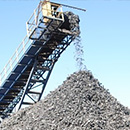
Iron and steel, also known as ferrous metals, are the most recycled materials in the United States and worldwide. Ferrous metals come from consumer products such as automobiles and household appliances, as well as industrial products including buildings, railroad tracks, ships, and farm equipment.
Recyclers use shredding, shearing, and other techniques to process the material for use in steel mills. The recycled iron and steel are then used in automobiles, bridges, buildings, public transportation, heavy equipment, and other materials.
Recycled iron and steel are the most important raw material inputs for U.S. steel production. In 2019, U.S. steel mills consumed more than 60 million metric tons of the recycled material to produce 87 million metric tons of steel.
The largest single source of obsolete iron and steel in the United States is end-of-life vehicles, providing
more than 13 million tons annually. The recycling of steel from automobiles is estimated to save the equivalent energy necessary to power 18 million homes every year.
Producing new steel from recycled content requires 60 percent less energy and reduces CO2 emissions by 58 percent compared with producing steel from virgin materials.
Recycling one car saves more than 2,500 lbs. of iron ore, 1,400 lbs. of coal, and 120 lbs. of limestone.
The industry recycles approximately 17 million vehicles in the U.S. annually, according to recent data.
The U.S. is the world’s leading recycled iron and steel exporting country, selling to buyers in 70 countries around the world and generating about $5 billion in export sales.
- You can tell if something is ferrous by holding a magnet up to it. If the magnet sticks, it is iron or steel.
- On average, the United States processes enough iron and steel every day to build 25 Eiffel Towers.
Sources: EPA, John Dunham & Associates
 Shredders and VOC Emissions
Shredders and VOC Emissions
Metal shredding operations have the potential to emit volatile organic compounds (VOCs) and depending upon the amount emitted have the potential to trigger regulatory and/or permit requirements under the Clean Air Act (CAA) and associated state regulations.
Learn More